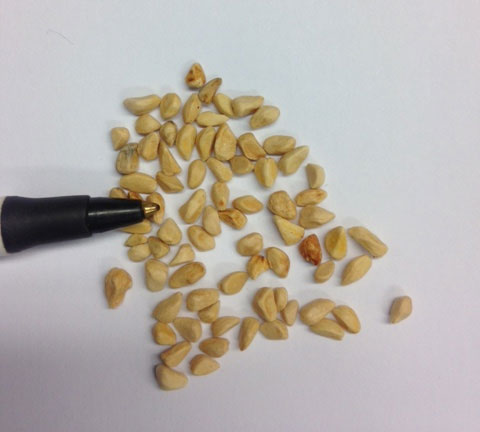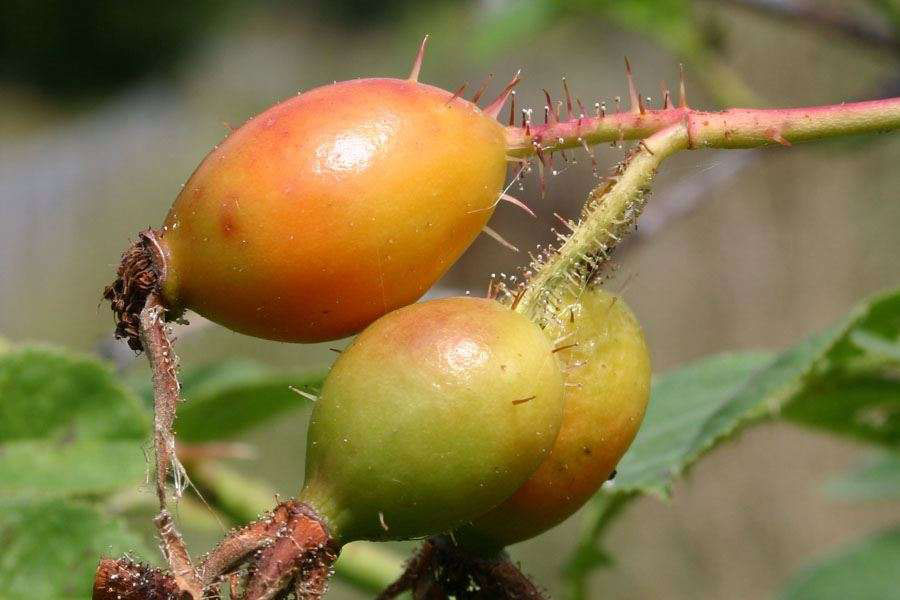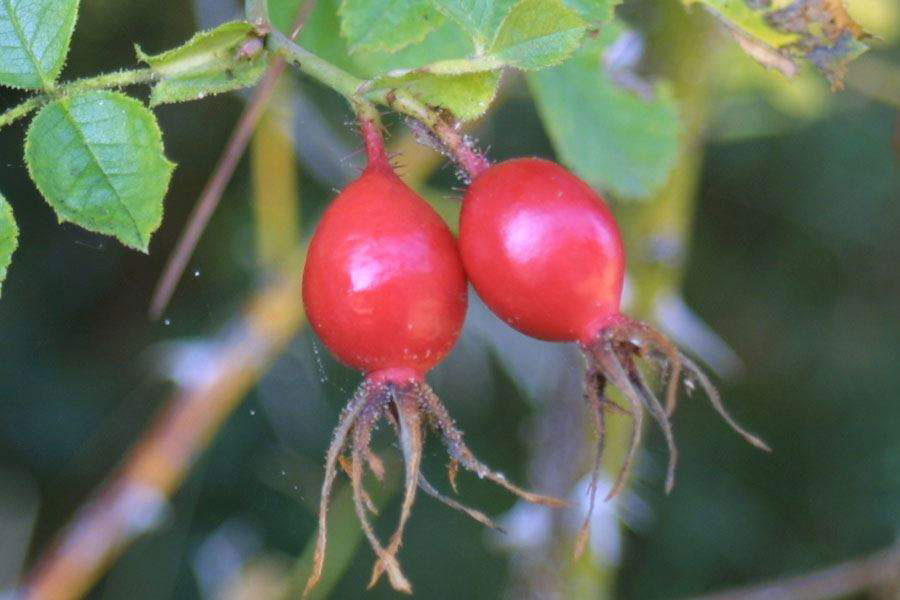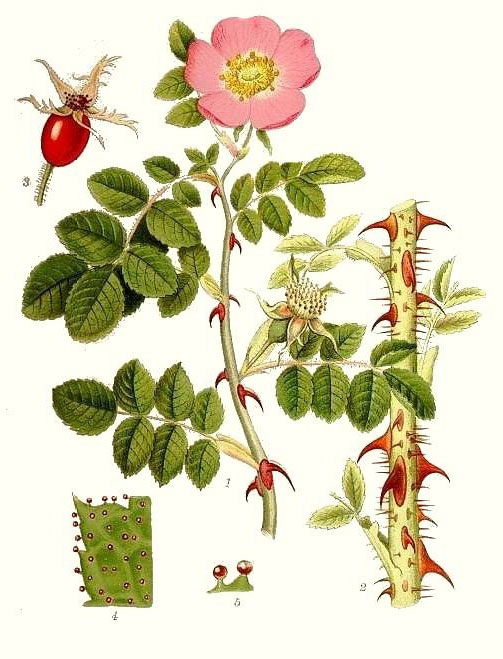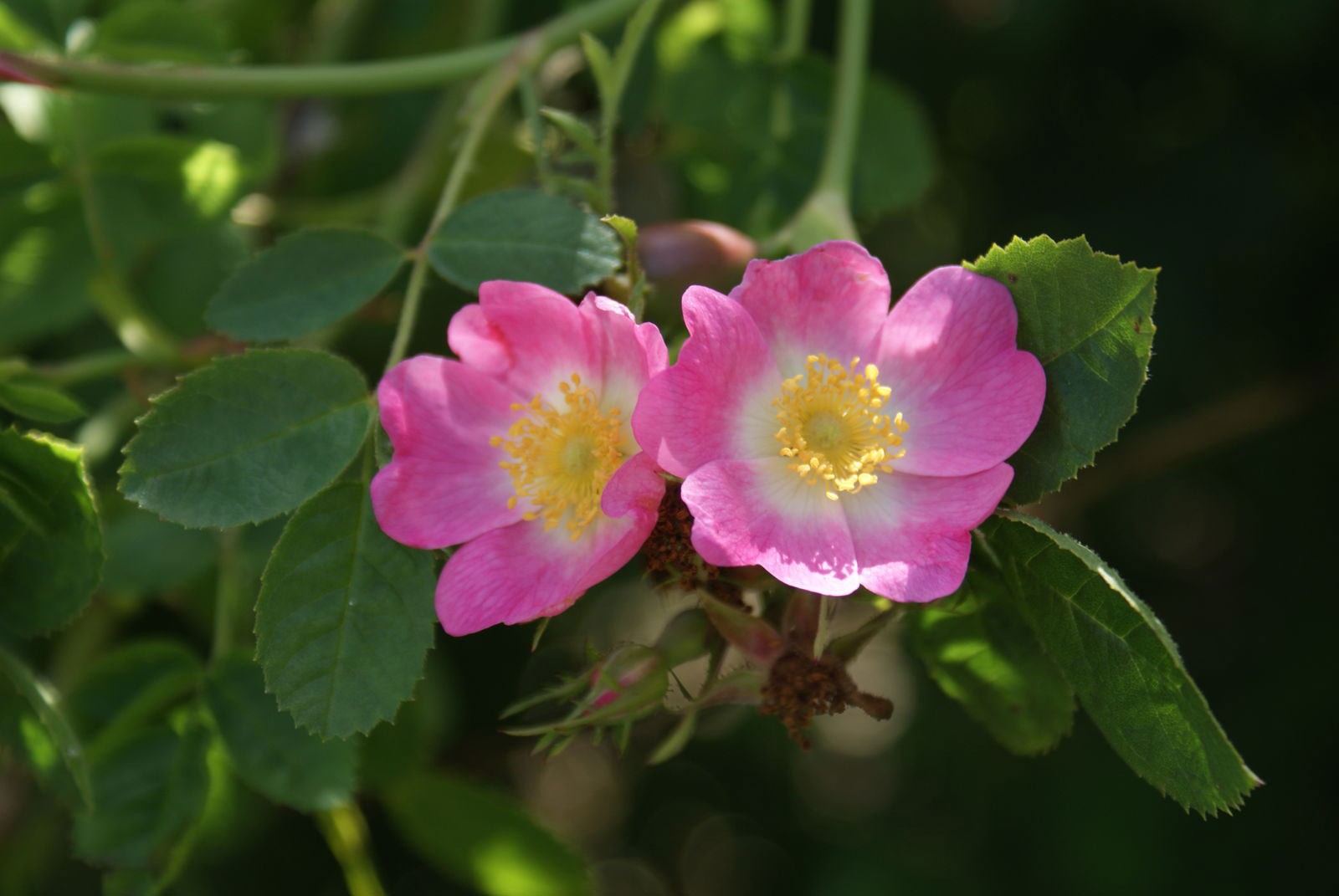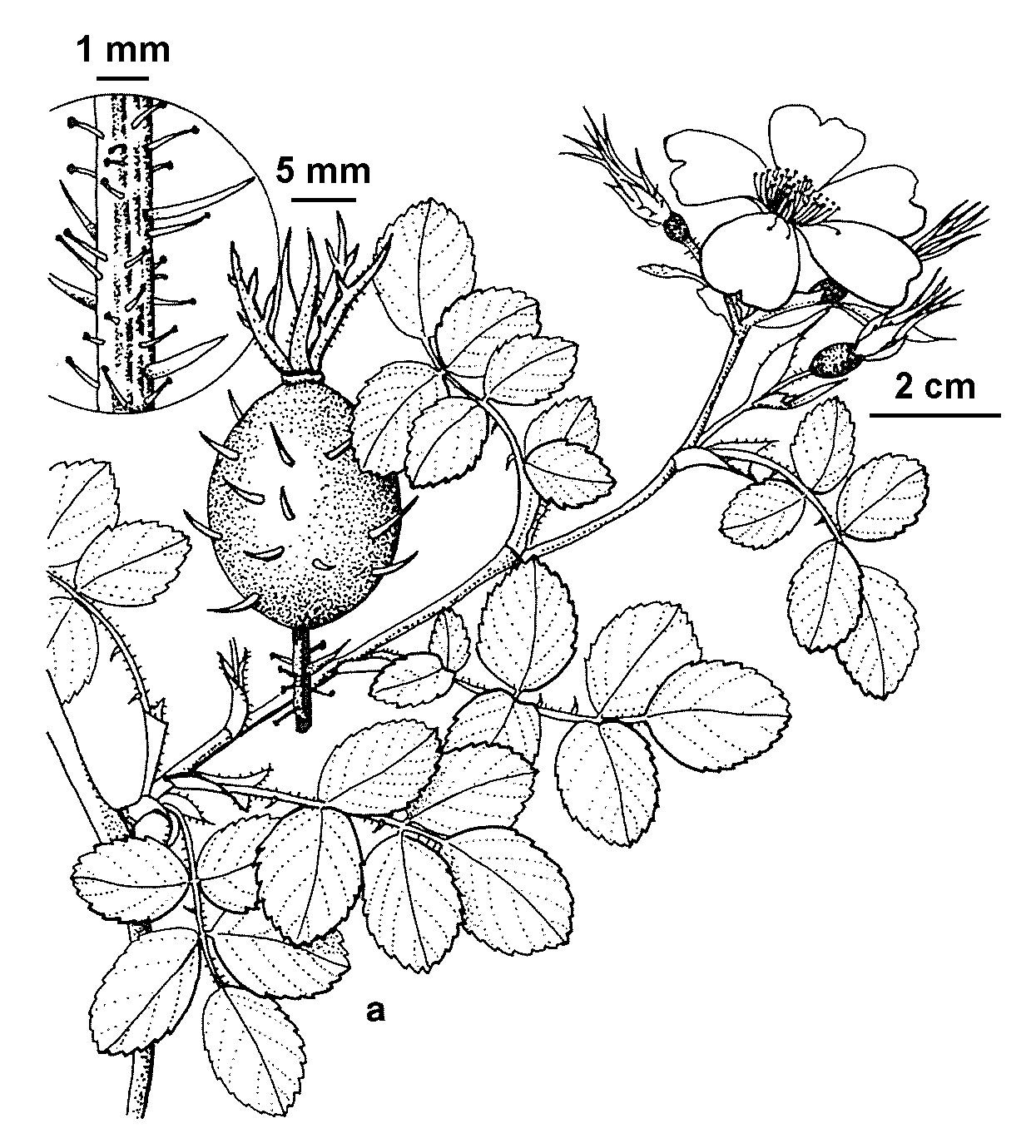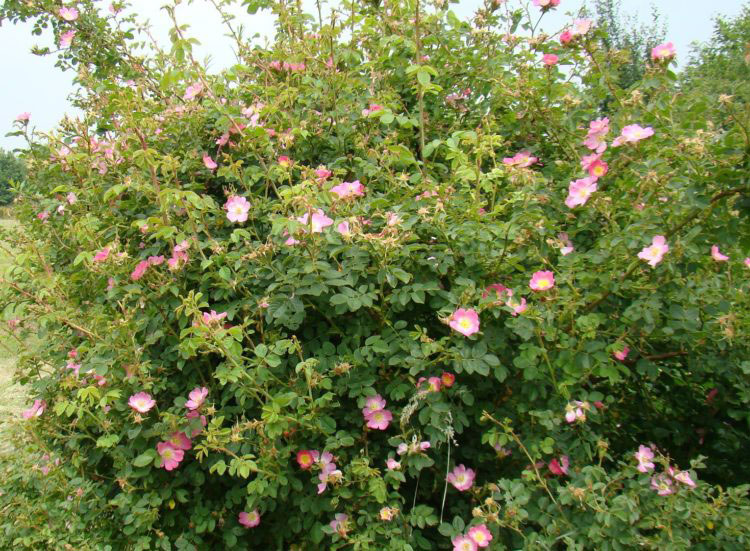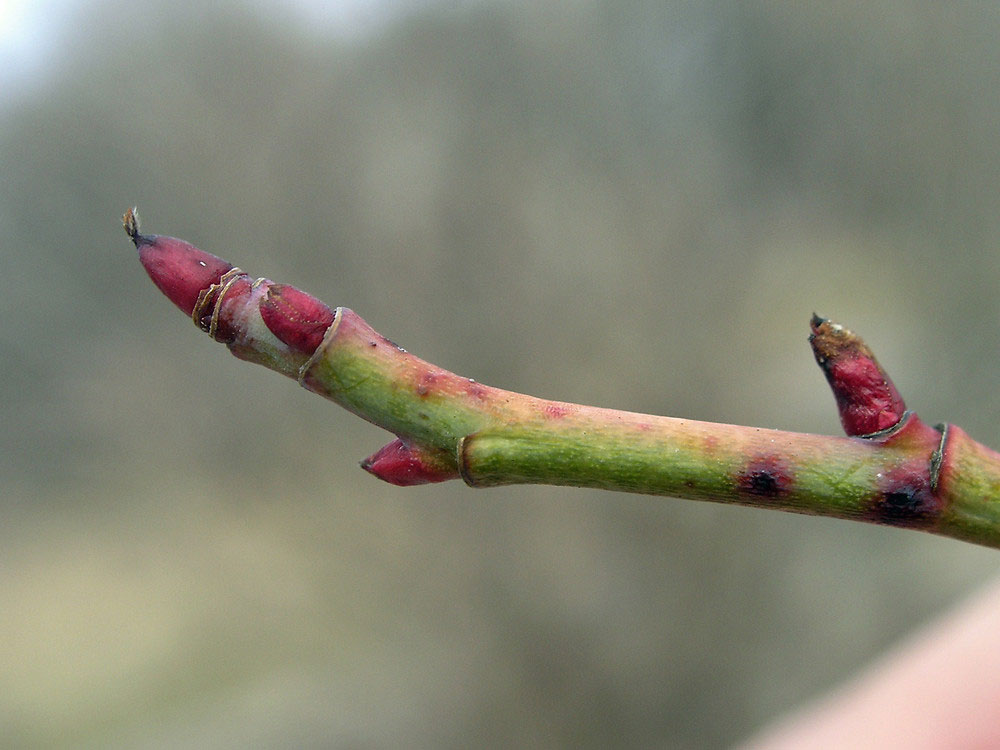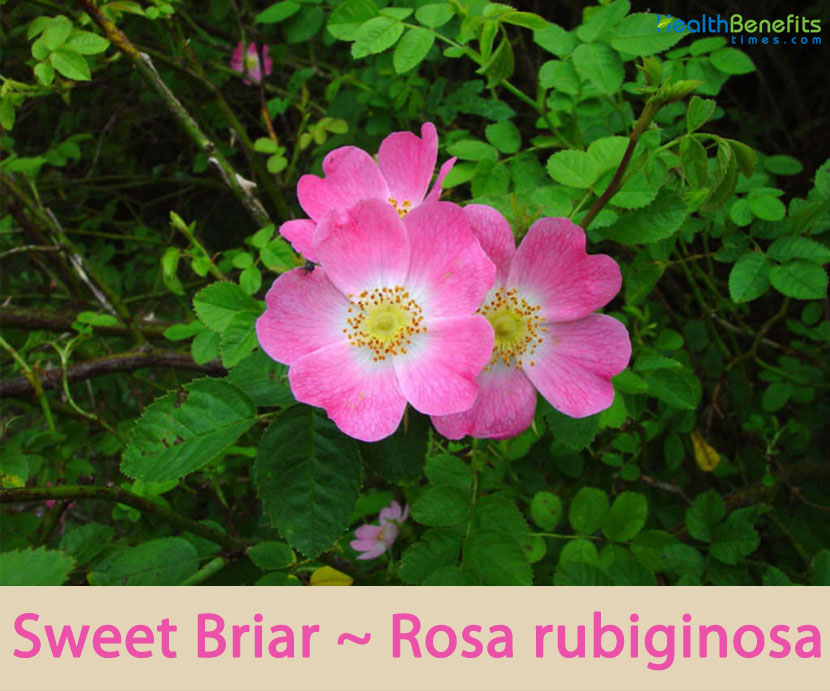 Rosa rubiginosa commonly known as sweet briar, sweetbriar rose or eglantine is a dense deciduous shrub belonging to Rosaceae (Rose family). The plant is native to Europe and western Asia. It widely naturalized in southern and eastern Australia (i.e. in the sub-coastal and inland districts of southern Queensland, in many parts of New South Wales and South Australia, in the ACT, in Victoria and Tasmania, and in the coastal districts of south-western Western Australia. Briar rose, eglantine, mosqueta rose, sweet briar, sweet briar rose, sweet brier, sweet brier rose and wild rose is some of the popular common names of the plant. Genus name comes from the Latin name for rose. Specific epithet means rusty. The plant is perhaps most noted for its aromatic dark green foliage that releases a sweetly fragrant perfume (suggestive of apples) after a rainstorm or when brushed with the hand.
Rosa rubiginosa commonly known as sweet briar, sweetbriar rose or eglantine is a dense deciduous shrub belonging to Rosaceae (Rose family). The plant is native to Europe and western Asia. It widely naturalized in southern and eastern Australia (i.e. in the sub-coastal and inland districts of southern Queensland, in many parts of New South Wales and South Australia, in the ACT, in Victoria and Tasmania, and in the coastal districts of south-western Western Australia. Briar rose, eglantine, mosqueta rose, sweet briar, sweet briar rose, sweet brier, sweet brier rose and wild rose is some of the popular common names of the plant. Genus name comes from the Latin name for rose. Specific epithet means rusty. The plant is perhaps most noted for its aromatic dark green foliage that releases a sweetly fragrant perfume (suggestive of apples) after a rainstorm or when brushed with the hand.
Sweet Briar Facts
| Name | Sweet briar |
|---|---|
| Scientific Name | Rosa rubiginosa |
| Native | Europe and western Asia |
| Common Names | Briar rose, eglantine, mosqueta rose, sweet briar, sweet briar rose, sweet brier, sweet brier rose, wild rose |
| Name in Other Languages | Afrikaans: Wilderoos Albanian: Trëndafil Arabic: Warada yaquti (ورد ياقوتي) Catalan: Englantina roja, gavarrera rubiginosa; roser rubiginós Croatian: Vinska ruža Czech: Růže vinná Danish: Æble-rose Dutch: Egelantier, Kleinbloemige roos, Kraagroos, Schijnegelantier, Wigbladige roos, wijnroos English: Eglantine, Sweet-briar, Sweetbriar, Sweetbriar rose, Briar rose Esperanto: Eglanterio Estonian: Näärmekas kibuvits Euskera: Otsolarra, sasi-arrosa Finnish: Omenaruusu, French: Rosier rouillé, Rosier églantier, Brier rose, Rosier églantier typique, Églantier odorant, rose rouille, rosier rubigineux, rosier à feuilles odorantes, rosier à odeur de pomme, églantier rouge, églantier rouillé , églantier à feuilles odorantes Galician: Dris chumhra German: Wein-Rose, Weinrose, Eglantierrose, schottische Zaunrose Hungarian: Rozsdás rózsa Irish: Dris chumhra Italian: Rosa balsamina, rosa rosso-bruno Japanese: Rosa balsamina, Rosa rubiginōsa (ロサ・ルビギノーサ) Kashubian: Recowatô róża Latvian: Smaržlapu roze Lithuania: Rūdėtasis erškėtis Majorcan: Regina, rosa groc, rosa groga Malayalam: Rēāsa ṟūbijinēāsa (റോസ റൂബിജിനോസ) Netherlands: Wijnroos Norwegian: Eplerose Polish: Róża rdzawa Portuguese: Rosa amarelle, rosa groga Russian: Shipovnik krasno-buryy (Шиповник красно-бурый), roza rzhavaya (роза ржавая), roza rzhavo-krasnaya (роза ржаво-красная), roza rzhavchinnaya (роза ржавчинная), eglanteriya (роза эглантерия), shipovnik rzhavo-krasnyy (шиповник ржаво-красный), shipovnik rzhavchinnyy (шиповник ржавчинный) Scottish Gaelic: Dris chumhra Slovak: Ruža hrdzavá Slovene: Rjastordeči šipek Spanish: Mosqueta fina amarilla; rosa herrumbrosa; rosa pajiza ordinaria, agavanzo, eglantina rosa, escaramujo, rosal hermoso, rosa sivestre Swedish: Äppelros Turkish: Yitik gül Ukrainian: Shypshyna volynsʹka (шипшина волинська), shypshyna irzhasto-chervona (шипшина іржасто-червона) Upper Sorbian: Winowa róža Welsh: Afalau’r Bwci, Bochgoch, Drysen Bêr, Drysi Pêr, Drysien Bêr, Dyrysien Bêr, Dyryslwyn, Egroes, Miaren, Miaren Bêr, Miaren Mair, Mieri, Mieryn Llwyn, Pêr-Freilen, Rhosllwyn Bêr, Rhoslwyn Pêr |
| Plant Growth Habit | Domed or erect, scrambling, woody, prickly, deciduous shrub or hedge plant |
| Growing Climates | Open copses, old hedgerows, grasslands, bushland, open woodlands, roadsides, waste areas, gullies, riparian vegetation, stabilized scree, steep open slopes and lakesides and pastures in temperate and cooler sub-tropical regions |
| Soil | Grows on a wide range of soil types. More abundant on well drained, calcareous soils of moderate to high fertility. Rarely on sands or poorly drained areas |
| Plant Size | Usually grows 1.5-2 m tall, but sometimes reaches up to 3 m in height |
| Root | Shallow perennial rootstock with many, long laterals in the top 300 mm of soil |
| Stem | Upright (i.e. erect) or arching stems are smooth and green or reddish in color when young, but become rough and woody as they mature |
| Leaf | Alternately arranged leaves are compound 5–9 cm long, with 5-7 (rarely nine) leaflets and a prickly stalk (i.e. petiole). The leaflets are 10-40 mm long and 5-28 mm wide and are egg-shaped in outline (i.e. ovate) or broadly oval (i.e. elliptic) in shape and have sharply toothed (i.e. serrated) margins |
| Flowering season | June to July |
| Flower | They have five pink, pinkish-white or white petals that are 8-25 mm long, numerous stamens, and five narrow sepals that are often covered in sticky (i.e. glandular) hairs. These flowers are borne on stalks (i.e. peduncles) that are covered in sticky (i.e. glandular) hairs |
| Fruit Shape & Size | Oval or egg-shaped fleshy capsule, 15-20 mm long, usually have a few bristles or small spines near their base and are topped with the remains of the sepals |
| Fruit Color | Green when young turning to orange or red in color as it matures |
| Seed | Numerous yellow seeds that are irregularly shaped about 4-7 mm long |
| Propagation | By seed, roots and suckers |
| Taste | Astringent, bitter |
| Plant Parts Used | Berries or fruit |
| Available Forms | Herbal teas, Jam, Jelly and Marmalade |
| Season | August to October |
| Other Forms |
|
Plant Description
Sweet briar is a domed or erect, scrambling, woody, prickly, deciduous shrub or hedge plant that normally grows about 1.5-2 m tall, but sometimes reaches up to 3 m in height. The plant is found growing in open copses, old hedgerows, grasslands, bush land, open woodlands, roadsides, waste areas, gullies, riparian vegetation, stabilized scree, steep open slopes and lakesides and pastures in temperate and cooler sub-tropical regions. The plant grows on a wide range of soil types. It is more abundant on well drained, calcareous soils of moderate to high fertility. It rarely grows on sands or poorly drained areas.
Stems
The upright (i.e. erect) or arching stems are smooth and green or reddish in color when young, but become rough and woody as they mature. They are armed with scattered, backward-curving (i.e. recurved), prickles of various sizes about 10-15 mm long.
Leaves
The alternately arranged leaves are compound 5–9 cm long, with 5-7 (rarely nine) leaflets and a prickly stalk (i.e. petiole). The leaflets are 10-40 mm long and 5-28 mm wide and are egg-shaped in outline (i.e. ovate) or broadly oval (i.e. elliptic) in shape and have sharply toothed (i.e. serrated) margins. There is also a pair of leafy bracts (i.e. stipules) present at the base of the leaf stalks (i.e. petioles) and the leaves have a few sticky (i.e. glandular) hairs on their undersides and along their margins. The foliage has a strong apple-like fragrance.
Flowers
The rather large flowers that are 20-50 mm across are borne in loose clusters at the tips of the branches. They have five pink, pinkish-white or white petals that are 8-25 mm long, numerous stamens, and five narrow sepals that are often covered in sticky (i.e. glandular) hairs. These flowers are borne on stalks (i.e. peduncles) that are covered in sticky (i.e. glandular) hairs. Flowering occurs mostly during spring and early summer.
Fruit
Fertile flowers are followed by an oval or egg-shaped fleshy capsule (called a ‘hip’) that turns orange or red in color as it matures. These capsules are 15-20 mm long, usually have a few bristles or small spines near their base and are topped with the remains of the sepals. They contain numerous yellow seeds that are irregularly shaped about 4-7 mm long.
Traditional Uses and benefits of Sweet briar
- Flowers and hips are aperient, astringent and stomachic.
- An infusion of dried rose petals can be used to treat headaches and dizziness, with honey added the infusion is used as a heart and nerve tonic and a blood purifier.
- Decoction of the petals is used to treat mouth sores.
- Seed is rich in vitamin E and oil extracted from the seed is used externally in the treatment of burns, scars and wrinkles.
- Fruit of this genus is a very rich source of vitamins and minerals, particularly in vitamins A, C and E, flavonoids and other bio-active compounds.
- It is being investigated as a food that is capable of reducing the incidence of cancer and also as a means of halting or reversing the growth of cancers.
- Rosehip is most popularly used to treat Skin problems.
- It makes your skin free from blemishes, wrinkles and makes you more beautiful, vibrant and young looking.
- Organic components in Rosehip reduce Cholesterol content in your body.
- It also aids the Cardiovascular System and lowers the chances of stroke or heart attack.
- Rosehips consist of huge amount of Vitamin C in them. It is thus the best way to boost Immune system.
- It encourages the production of white blood cells in the Body and prevents asthma and reduces respiratory problems like colds and flu.
- Rosehip consists of good amount of Iron. It thus boosts the production of Red blood cells in the Body and prevents the risk of anemia.
- It regulates the blood sugar levels in the body.
- It helps to eliminate toxins from the Body.
- It stimulates the bowel movement. The Pectin acid in Rosehip induces urination and excretion.
- Vitamin C aids the production of collagen in the body and prevents the state of Osteoporosis.
- They are used to prevent or treat cold.
Ayurvedic Health benefits of Sweet Briar
- Rosacea: Apply Rosehip oil over the affected area.
- Osteoarthritis: Rosehip consists of compounds like Galactolipid, Polyphenols and Anthocyanins. These compounds help in reducing the joint pains and inflammation. It eases the joint movement and treats Osteoarthritis. Have a cup of Rosehip tea daily.
- Rheumatoid Arthritis: Rosehip tea helps in reducing the Joint Stiffness and eases the movement. It helps in reducing the Joint pain and Inflammation associated with Rheumatoid Arthritis.
- Respiratory Ailments: Rosehip is a good herbal treatment for Respiratory Ailments such as Asthma, Cold, Chronic Cough and Flu.
- Cancer: Rosehip tea is effective to prevent the abnormal growth of cells in the Body. The Rosehip extract is beneficial in preventing Breast Cancer.
- Cholesterol: Rosehip reduces the stress in the blood streams and prevents the risk of Heart Attack. It reduces the high levels of Cholesterol in the bloodstreams. It also reduces the risk of cardiovascular diseases. Have a cup of Rosehip tea every day.
- Immunity: Rosehips contain more Vitamin C as compare to Oranges. Vitamin C helps in the formation of Collagen and stimulates the White Blood Cells. Rosehips also contain Vitamin A, which helps to fight against bacterial and viral infections. This makes the immune system strong.
- Diabetes: Rosehips is beneficial for Diabetic patients, as it regulates the Glucose levels in the Blood. Have a cup of Rosehip tea every day.
- High Blood Pressure: It prevents the deposition of plaque in the arteries and reduces the risk of Heart Diseases. Have a cup of Rosehip tea every day.
- Anemia: Rosehip contains a good amount of Iron. Have a cup of Rosehip tea every day.
- Digestive and Stomach Disorders: It stimulates the bowel movement and treats stomach and digestive disorders like Stomach pain, Diarrhea and Urinary Tract Infections.
- Bone Health: Rosehip treats Bone diseases such as Osteoarthritis, Rheumatoid Arthritis and reduces the risk of Osteoporosis.
- Blackheads: Take two drops of Jojoba oil, one drop each of Rose Hip and Lavender oil. Apply over the face.
Culinary Uses
- Fruit is cooked and used in making jellies etc.
- Pleasant tasting fruity-flavored tea is made from the fruit; it is rich in vitamin C.
- Petals can be consumed raw or cooked. Remove the bitter white base.
- It is also used in confectionery.
- Young shoots can also be consumed raw.
- The seed is a good source of vitamin E; it can be ground into a powder and mixed with flour or added to other foods as a supplement. Be sure to remove the seed hairs
Other Facts
- The plant makes a good low hedge.
- Prickles on the stem make it a useful security hedge.
- The leaves are apple-scented.
- The flowers are slightly scented.
- Natural flower water is produced from its flowers in Tunisia.
- In Chile and Argentina, where it is known in Spanish language as “Rosa Mosquito”, it can be found in the wild around the Andes range and is also cultivated to produce marmalades and cosmetic products.
Precautions
- There is a layer of hairs around the seeds just beneath the flesh of the fruit.
- These hairs can cause irritation to the mouth and digestive tract if ingested.
- People suffering from diabetes or any blood related disease, sickle cell disease must consult doctor before using Rosehip.
- Consult your doctor or physician if you are pregnant or breastfeeding.
- Rosehip can cause side effects to people who are food allergic or allergic to the particular flower.
- Some of the side effects are nausea, vomiting, headaches, heartburn and inability to sleep.
- Inhaling rosehip powder can cause irritation within the lungs.
- It is observed that topical use of rosehip oil on skin can cause skin irritation or itching.
- Consumption of Rosehip may cause Intestinal problems as upset stomach, bloating and Diarrhea. Consult your Doctor or Physician before consuming Rosehip.
Control
Sweetbriar rose is difficult to control due to its large size and regeneration from sprouts. Control often requires multiple years of treatment. Plants can be eliminated by extracting from the ground with an ATV or other vehicle in the spring, then spraying the sprouts that emerge with an herbicide. In areas where plants are numerous, mowing with a brush machine will facilitate herbicide application. Effective herbicides include glyphosate, picloram plus 2-4-D, and triclopyr ester.
Contact your local agricultural extension specialist or county weed specialist to learn what works best in your area and how to use it safely. Always read label and safety instructions for each control method. Trade names and control measures appear in this document only to provide specific information. USDA NRCS does not guarantee or warranty the products and control methods named, and other products may be equally effective.
Other Methods
- Grazing: Grazing by livestock such as sheep is unlikely to control mature Briar Rose plants due to their prickly nature, however seedlings can be controlled through periodic heavy grazing.
- Chemical Control: Techniques such as ‘cut and paint’ are useful for small numbers of plants. Larger infestations may be foliar sprayed. Herbicides registered for use in Tasmania include metsulfuron methyl, triclopyr and glyphosate.
References:
https://www.itis.gov/servlet/SingleRpt/SingleRpt?search_topic=TSN&search_value=520258#null
https://pfaf.org/user/plant.aspx?LatinName=Rosa+rubiginosa
https://en.wikipedia.org/wiki/Rosa_rubiginosa
https://plants.usda.gov/home/plantProfile?symbol=RORU82
https://keyserver.lucidcentral.org/weeds/data/media/Html/rosa_rubiginosa.htm
https://www.cabi.org/isc/datasheet/47833
http://www.naturalmedicinalherbs.net/herbs/r/rosa-rubiginosa=sweet-briar.php
http://www.eu-nomen.eu/portal/taxon.php?GUID=E41DDAD3-22E6-40D0-AE76-DF5408EC1F42


